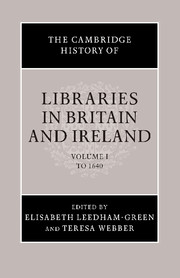Book contents
- Frontmatter
- Introduction
- The physical setting
- Part One The medieval library
- Part Two Reformation, dissolution, new learning
- 10 The dispersal of the monastic libraries and the salvaging of the spoils
- 11 Extending the frontiers: scholar collectors
- 12 Matthew Parker’s manuscripts: an Elizabethan library and its use
- Part Three Tools of the trade
- Part Four Libraries for leisure
- Part Five Organisation and administration
- Select bibliography
- General index
- Index of manuscripts
- References
10 - The dispersal of the monastic libraries and the salvaging of the spoils
from Part Two - Reformation, dissolution, new learning
Published online by Cambridge University Press: 28 March 2008
- Frontmatter
- Introduction
- The physical setting
- Part One The medieval library
- Part Two Reformation, dissolution, new learning
- 10 The dispersal of the monastic libraries and the salvaging of the spoils
- 11 Extending the frontiers: scholar collectors
- 12 Matthew Parker’s manuscripts: an Elizabethan library and its use
- Part Three Tools of the trade
- Part Four Libraries for leisure
- Part Five Organisation and administration
- Select bibliography
- General index
- Index of manuscripts
- References
Summary
Relatively little concrete evidence remains concerning the contents of the English monastic libraries in the years leading up to the major dissolutions of the second half of the 1530s, and the only complete catalogue compiled after 1500 still extant is that of the brothers’ library in the Bridgettine house of Syon (c. 1500–c. 1524). The booklists which do survive, primarily those compiled by John Leland, were selective in nature and throw more light on the interests of the compiler than on the material contained in the monasteries themselves. In his De uiris illustribus, or Commentarii de scriptoribus Britannicis as it was called by its eighteenth-century editor, Leland included several brief sketches of monastic libraries, and these suggest widely differing conditions from house to house and order to order. For the most part, the Benedictines were singled out for praise, and Leland was lyrical in his evocation of the well-stocked library at Glastonbury, which he visited in the summer of 1533.
At Bath he was impressed by the ancient books which had survived up to his time (Scriptores, 160), and he mentioned that the famous library at St Albans was likewise stocked with ancient books (Scriptores, 166). The cathedral priory at Norwich, he stated, was ‘crammed with good books’ (Scriptores, 247), and he saluted Ramsey as a ‘storehouse of ancient authors’ (Scriptores, 264). St Augustine’s, Canterbury, was described as ‘a rich storehouse of ancient manuscripts’ in spite of a terrible fire in 1168 and later depredations by ignorant monks (Scriptores, 299–301). The library at Abingdon had been neglected, but nevertheless Leland found a particular gem, a copy of Joseph of Exeter’s lost Antiocheis, while rooting through ‘the dust and moths’ (Scriptores, 238).
- Type
- Chapter
- Information
- The Cambridge History of Libraries in Britain and Ireland , pp. 265 - 291Publisher: Cambridge University PressPrint publication year: 2006
References
- 6
- Cited by

